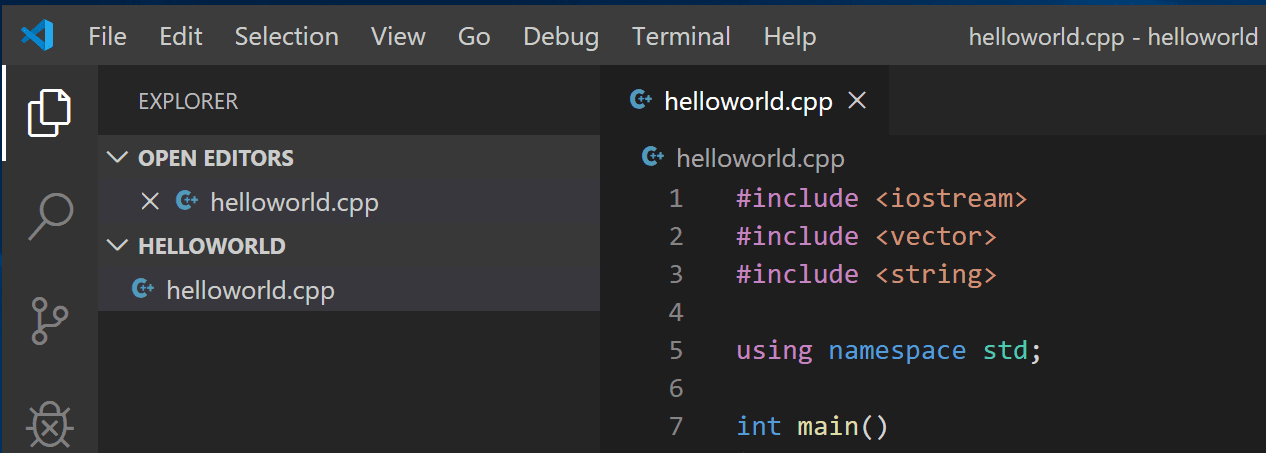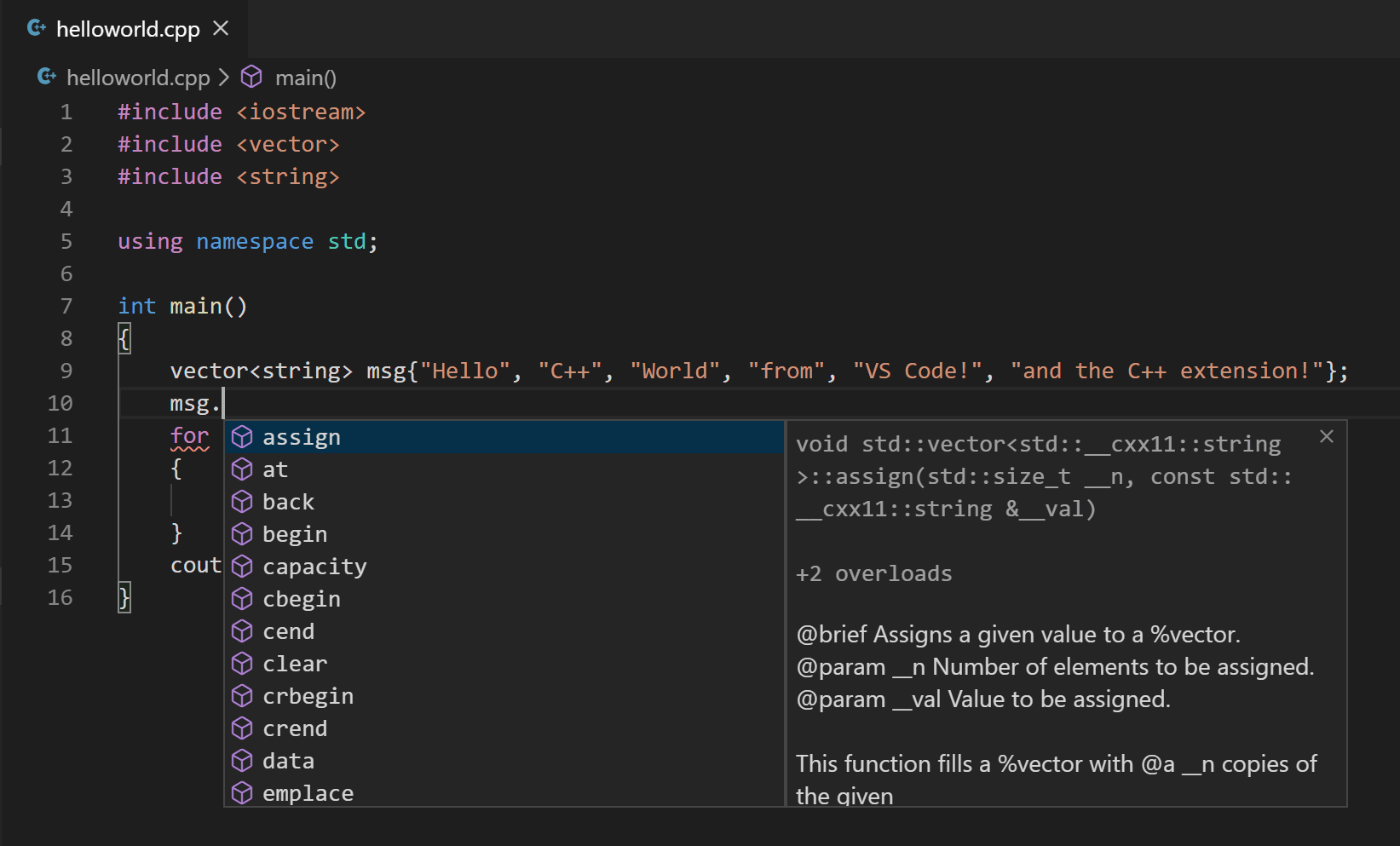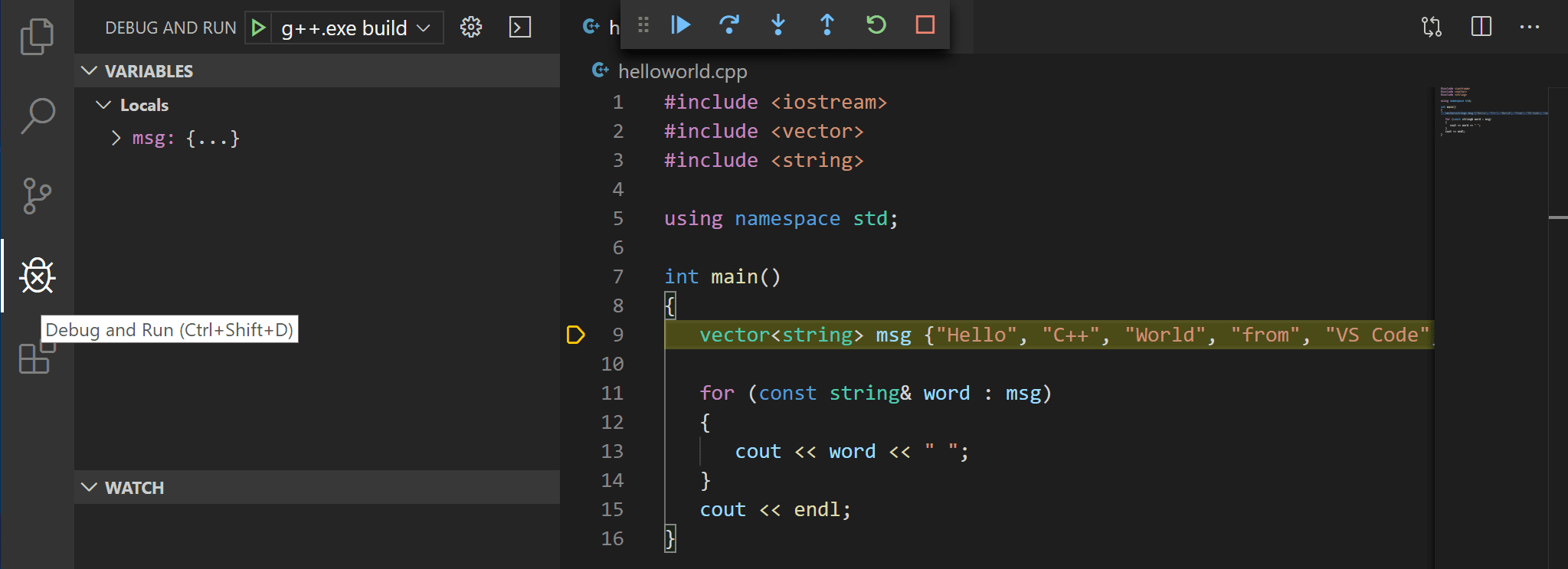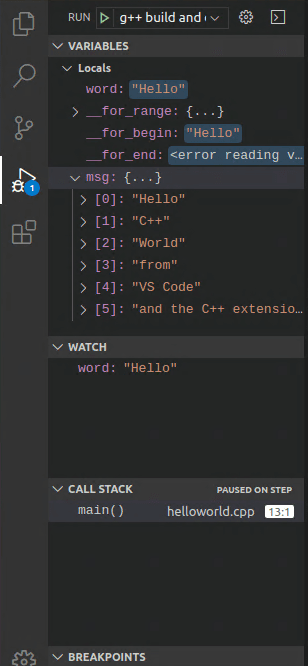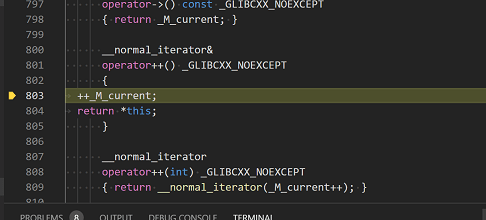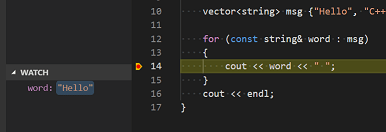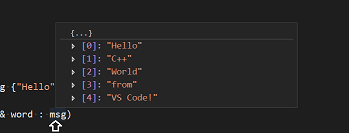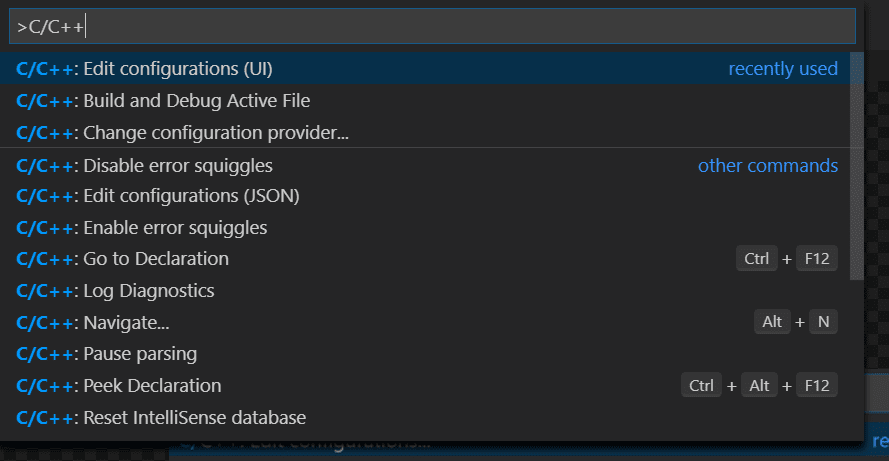- Setting up MinGW-w64
- Install MinGW-w64
- Test MinGW-w64
- Change name of the make executable
- Next steps
- Where to go from here?
- OpenCV C++ installation on Windows with MinGW
- Prerequisites
- Step 1
- Step 2
- Step 3
- Step 4
- Step 5
- Using GCC with MinGW
- Prerequisites
- Check your MinGW installation
- Create Hello World
- Add a source code file
- Add hello world source code
- Explore IntelliSense
- Build helloworld.cpp
- Running the build
- Modifying tasks.json
- Debug helloworld.cpp
- Start a debugging session
- Step through the code
- Set a watch
- C/C++ configurations
- Compiler path
Setting up MinGW-w64
Install MinGW-w64
MinGW-w64 comprises development tools for compiling and debugging. Download the Mingw-w64 Installer from here and follow the steps in the wizard. It is essential that the installation path does not contain any spaces. Therefore, you cannot install MinGW-w64 in Program Files. We recommend to create a folder mingw-w64 on your system drive (e.g., C:\mingw). Install a current version and specify win32 as thread when requested. Additionally, choose the architecture x86_64 .
After installing, you need to edit the PATH variable. You can access the System Control Center by pressing Windows Key + Pause . In the System window, click Advanced System Settings → Advanced (tab) → Environment Variables . For Windows 10, a quick access is to enter «Edit the system environment variables» in the Start Search of Windows and click the button «Environment Variables». Change the PATH variable (double-click on it or Select and Edit ), and add the path where your MinGW-w64 has been installed to e.g., C:\mingw\mingw64\bin . This folder should contain a number of .exe-files that you can see in your Explorer.
Test MinGW-w64
Open the command prompt of Windows either via the Program Menu or type cmd in the Start Search of Windows. Enter:
If you get an error such as «Command g++ not found», then something went wrong. In this case, verify that the PATH variable was successfully set and directs to the correct installation path. Additionally, open a new command prompt and try to execute the command again. If you try to reinstall, do not forget to restart the command prompt again (it does not update automatically). If this does not help, please ask for advice in the Forum.
Change name of the make executable
In your installation folder, inside the bin directory, you should find a file called mingw32-make.exe . Create a copy of the file in the same directory named make.exe . This is because this file is the one you will use to compile 4diac FORTE, and «make» is the command used for that throughout the documentation.
Next steps
Now that you successfully installed a compiler, you can continue with the next step of the installation tutorial. All information in the installation tutorial is based on a setup with MinGW-w64. For users with previous experience in building a 4diac FORTE, the details are listed:
- When generating files for compiling in CMake, the tool «Unix Makefiles» has to be selected.
- Also the architecture option needs to be set in CMake: The correct FORTE_ARCHITECTURE is Win32
- When compiling, open the Windows command line and go to the folder, where CMake built the binaries. Execute the command make to compile.
Where to go from here?
If you want to build a 4diac FORTE, here is a quick link back:
If you want to go back to the Start Here page, we leave you here a fast access
OpenCV C++ installation on Windows with MinGW
These days getting OpenCV running inside python is quite easy given conda does handle the installing the binaries and bringing the opencv python bindings inside python path.
However getting the same to run in C++ , is a different story. C++ is all about bringing in the right interface (hpp/header files) and binaries (so/dll) in the context of the program being compiled by the “g++” compiler. I will show you how I was able to set my system up for the same. Most tutorials out there will consider using an IDE like Eclipse or Netbeans. For bringing in “g++” (GNU C++ compiler) , we will use MinGW64. Remember we must use the 64bit variant since Mingw32 does not supports posix threads properly in windows. The ming64 binaries are built with a posix implementation that gives native posix but when compiled on windows will be slower compared to something built on windows native API (win32)
Prerequisites
- Windows (10/8/7) system
- Mingw-w64 , you can download from here
- OpenCv 3+ , official github repo
- Cmake , download from here
- Editor and terminal, do not care what you use. You can use notepad 😥 if you wish.
Step 1
Download the OpenCV source from their official git repository. You can choose to download any one of them. In my case I went for this one
Step 2
Setup Mingw-w64. In case you had trouble finding the link. Look here . Go for the link that says Online Installer for MinGW-GW64. Direct link , may break in future.
- Install MinGW-GW64 with the following setting
Make sure posix is selected. Otherwise the OpenCV installation will fail with unable to find mutex error. Which is part of pthreads library and specs. Architecture can be x86(32/64 bit machin) or x86_64(64bit machine) based on your working system.
2. Click next configure path of installation and let the binaries install.
3. After installation make sure to include MinGW bin folder in your path. It should be inside “..basePath/x86_64–8.1.0-posix***/mingw64/bin”
After this just test the installation by opening a terminal and type command “g++ — version”. If it says command not found. It could not get the path ,path was not set right, restart terminal or the machine. It should work! Google for the same !
Step 3
Once done install Cmake. Open Cmake and do the following
- Choose a source code path and a binaries path. Make sure they are separate.
2. Once done click on configure.A dialogue box will appear select MinGW Makefiles. This will make sure that the OpenCV new makefiles are compatible to mingw.
3. Click Finish. Let it generate some stuff. At this stage you should have some list of options to tick on. I did not needed any special attention to any of those options. So go on and click on Generate. Match the output from below, it should say “Configuration done” and “Generating done”
Step 4
Remember we chose a binaries folder, keep that in mind. Now navigate to that folder and open a terminal. In my case the folder I will have to navigate is.
“ C:\Users\Asus\Desktop\opencv”. Open a terminal in this folder. I use git-bash and you can use too. hit command “mingw32-make install” and pray that it builds hopefully. Because if it does my tutorial was successful.
After it’s done it should look like this. Also C++ compilation process takes a lot of time, LOT OF TIME . There are conference discussion on the same !! So you understand how serious is this problem.
At this point a new folder install will be created in your targeted build folder. We are concerned with the contents of this folder. So let’s do one thing. Lets move our build folder to “C:” drive root path that contains the install folder also. Now we add the binary path. Refer from the above image. In the environment variable there is a second path that points at the bin folder add that to environment variable also. Path “ C:\opencv\install\x64\mingw\bin” must be included in environment variable. This was in our case. These paths are IMPORTANT . 😧 Make sure it is there. The bin folder consist of all the various compiled binaries that are required for our OpenCV C++ compiled application. So you can choose to ship your application but then you will require the dll inside the bin to be shipped with your application also. Also since they are dll you cannot statically link them. So “-static” does not works. At least I could not get it done.
Step 5
Write a program
Now once you have the code copied. It’s time to test the installation. Remember to change the image location to your target image. Make sure you do that otherwise empty Mat will be created.
Double check that the include ,lib and bin folder of the install folder are targeted by your g++ compilation command.
If your command worked with no error. If there are linker errors then would advice to check whether linked dll are existing in the folder included by the command.
So hopefully you got a similar out put of size of the image currently being used.
Hope this tutorial helps you start your journey into the rabbit hole of C++ and Computer Vision. For more such content to follow this blog and if you found this helpful maybe a few claps. 😄 ….
Hopefully in the next version we will try to support cuda for Opencv DNN module.
Using GCC with MinGW
In this tutorial, you configure Visual Studio Code to use the GCC C++ compiler (g++) and GDB debugger from mingw-w64 to create programs that run on Windows.
After configuring VS Code, you will compile and debug a simple Hello World program in VS Code. This tutorial does not teach you about GCC, GDB, Mingw-w64, or the C++ language. For those subjects, there are many good resources available on the Web.
If you have any problems, feel free to file an issue for this tutorial in the VS Code documentation repository.
Prerequisites
To successfully complete this tutorial, you must do the following steps:
Install the C/C++ extension for VS Code. You can install the C/C++ extension by searching for ‘c++’ in the Extensions view ( ⇧⌘X (Windows, Linux Ctrl+Shift+X ) ).
Install Mingw-w64 via the SourceForge website. Click Mingw-w64 to download the Windows Mingw-w64 installer.
- Run the installer.
- For Architecture select x86_64 and then select Next.
- On the Installation Folder page, use the default installation folder. Copy the location as you will need it later.
- Select Next to start the installation.
Add the path to your Mingw-w64 bin folder to the Windows PATH environment variable by using the following steps:
- In the Windows search bar, type ‘settings’ to open your Windows Settings.
- Search for Edit environment variables for your account.
- Choose the Path variable and then select Edit.
- Select New and add the Mingw-w64 destination folder path to the system path. The exact path depends on which version of Mingw-w64 you have installed and where you installed it. If you used the settings above to install Mingw-w64, then add this to the path: C:\Program Files\mingw-w64\x86_64-8.1.0-posix-seh-rt_v6-rev0\mingw64\bin .
- Select OK to save the updated PATH. You will need to reopen any console windows for the new PATH location to be available.
Check your MinGW installation
To check that your Mingw-w64 tools are correctly installed and available, open a new Command Prompt and type:
If you don’t see the expected output or g++ or gdb is not a recognized command, check your installation (Windows Control Panel > Programs) and make sure your PATH entry matches the Mingw-w64 binary location where the compilers are located.
Create Hello World
From a Windows command prompt, create an empty folder called projects where you can place all your VS Code projects. Then create a sub-folder called helloworld , navigate into it, and open VS Code in that folder by entering the following commands:
The «code .» command opens VS Code in the current working folder, which becomes your «workspace». As you go through the tutorial, you will see three files created in a .vscode folder in the workspace:
- tasks.json (build instructions)
- launch.json (debugger settings)
- c_cpp_properties.json (compiler path and IntelliSense settings)
Add a source code file
In the File Explorer title bar, select the New File button and name the file helloworld.cpp .
Add hello world source code
Now paste in this source code:
Now press ⌘S (Windows, Linux Ctrl+S ) to save the file. Notice how the file you just added appears in the File Explorer view ( ⇧⌘E (Windows, Linux Ctrl+Shift+E ) ) in the side bar of VS Code:
You can also enable Auto Save to automatically save your file changes, by checking Auto Save in the main File menu.
The Activity Bar on the far left lets you open different views such as Search, Source Control, and Run. You’ll look at the Run view later in this tutorial. You can find out more about the other views in the VS Code User Interface documentation.
Note: When you save or open a C++ file, you may see a notification from the C/C++ extension about the availability of an Insiders version, which lets you test new features and fixes. You can ignore this notification by selecting the X (Clear Notification).
Explore IntelliSense
In your new helloworld.cpp file, hover over vector or string to see type information. After the declaration of the msg variable, start typing msg. as you would when calling a member function. You should immediately see a completion list that shows all the member functions, and a window that shows the type information for the msg object:
You can press the Tab key to insert the selected member; then, when you add the opening parenthesis, you will see information about any arguments that the function requires.
Build helloworld.cpp
Next, you’ll create a tasks.json file to tell VS Code how to build (compile) the program. This task will invoke the g++ compiler to create an executable file based on the source code.
From the main menu, choose Terminal > Configure Default Build Task. In the dropdown, which will display a tasks dropdown listing various predefined build tasks for C++ compilers. Choose g++.exe build active file, which will build the file that is currently displayed (active) in the editor.
This will create a tasks.json file in a .vscode folder and open it in the editor.
Your new tasks.json file should look similar to the JSON below:
The command setting specifies the program to run; in this case that is g++. The args array specifies the command-line arguments that will be passed to g++. These arguments must be specified in the order expected by the compiler. This task tells g++ to take the active file ( $
Note: You can learn more about tasks.json variables in the variables reference.
The label value is what you will see in the tasks list; you can name this whatever you like.
The «isDefault»: true value in the group object specifies that this task will be run when you press ⇧⌘B (Windows, Linux Ctrl+Shift+B ) . This property is for convenience only; if you set it to false, you can still run it from the Terminal menu with Tasks: Run Build Task.
Running the build
Go back to helloworld.cpp . Your task builds the active file and you want to build helloworld.cpp .
To run the build task defined in tasks.json , press ⇧⌘B (Windows, Linux Ctrl+Shift+B ) or from the Terminal main menu choose Run Build Task.
When the task starts, you should see the Integrated Terminal panel appear below the source code editor. After the task completes, the terminal shows output from the compiler that indicates whether the build succeeded or failed. For a successful g++ build, the output looks something like this:
Create a new terminal using the + button and you’ll have a new terminal with the helloworld folder as the working directory. Run dir and you should now see the executable helloworld.exe .
You can run helloworld in the terminal by typing helloworld.exe (or .\helloworld.exe if you use a PowerShell terminal).
Note: You might need to press Enter a couple of times initially to see the PowerShell prompt in the terminal. This issue should be fixed in a future release of Windows.
Modifying tasks.json
You can modify your tasks.json to build multiple C++ files by using an argument like «$
Debug helloworld.cpp
Next, you’ll create a launch.json file to configure VS Code to launch the GDB debugger when you press F5 to debug the program.
- From the main menu, choose Run >Add Configuration. and then choose C++ (GDB/LLDB).
- You’ll then see a dropdown for various predefined debugging configurations. Choose g++.exe build and debug active file.
VS Code creates a launch.json file, opens it in the editor, and builds and runs ‘helloworld’.
The program setting specifies the program you want to debug. Here it is set to the active file folder $
By default, the C++ extension won’t add any breakpoints to your source code and the stopAtEntry value is set to false .
Change the stopAtEntry value to true to cause the debugger to stop on the main method when you start debugging.
Note: The preLaunchTask setting is used to specify task to be executed before launch. Make sure it is consistent with the tasks.json file label setting.
Start a debugging session
- Go back to helloworld.cpp so that it is the active file.
- Press F5 or from the main menu choose Run > Start Debugging. Before you start stepping through the source code, let’s take a moment to notice several changes in the user interface:
-
The Integrated Terminal appears at the bottom of the source code editor. In the Debug Output tab, you see output that indicates the debugger is up and running.
The editor highlights the first statement in the main method. This is a breakpoint that the C++ extension automatically sets for you:
The Run view on the left shows debugging information. You’ll see an example later in the tutorial.
At the top of the code editor, a debugging control panel appears. You can move this around the screen by grabbing the dots on the left side.
Step through the code
Now you’re ready to start stepping through the code.
Click or press the Step over icon in the debugging control panel.
This will advance program execution to the first line of the for loop, and skip over all the internal function calls within the vector and string classes that are invoked when the msg variable is created and initialized. Notice the change in the Variables window on the left.
In this case, the errors are expected because, although the variable names for the loop are now visible to the debugger, the statement has not executed yet, so there is nothing to read at this point. The contents of msg are visible, however, because that statement has completed.
Press Step over again to advance to the next statement in this program (skipping over all the internal code that is executed to initialize the loop). Now, the Variables window shows information about the loop variables.
Press Step over again to execute the cout statement. (Note that as of the March 2019 release, the C++ extension does not print any output to the Debug Console until the loop exits.)
If you like, you can keep pressing Step over until all the words in the vector have been printed to the console. But if you are curious, try pressing the Step Into button to step through source code in the C++ standard library!
To return to your own code, one way is to keep pressing Step over. Another way is to set a breakpoint in your code by switching to the helloworld.cpp tab in the code editor, putting the insertion point somewhere on the cout statement inside the loop, and pressing F9 . A red dot appears in the gutter on the left to indicate that a breakpoint has been set on this line.
Then press F5 to start execution from the current line in the standard library header. Execution will break on cout . If you like, you can press F9 again to toggle off the breakpoint.
When the loop has completed, you can see the output in the Integrated Terminal, along with some other diagnostic information that is output by GDB.
Set a watch
Sometimes you might want to keep track of the value of a variable as your program executes. You can do this by setting a watch on the variable.
Place the insertion point inside the loop. In the Watch window, click the plus sign and in the text box, type word , which is the name of the loop variable. Now view the Watch window as you step through the loop.
Add another watch by adding this statement before the loop: int i = 0; . Then, inside the loop, add this statement: ++i; . Now add a watch for i as you did in the previous step.
To quickly view the value of any variable while execution is paused on a breakpoint, you can hover over it with the mouse pointer.
C/C++ configurations
If you want more control over the C/C++ extension, you can create a c_cpp_properties.json file, which will allow you to change settings such as the path to the compiler, include paths, C++ standard (default is C++17), and more.
You can view the C/C++ configuration UI by running the command C/C++: Edit Configurations (UI) from the Command Palette ( ⇧⌘P (Windows, Linux Ctrl+Shift+P ) ).
This opens the C/C++ Configurations page. When you make changes here, VS Code writes them to a file called c_cpp_properties.json in the .vscode folder.
Here, we’ve changed the Configuration name to GCC, set the Compiler path dropdown to the g++ compiler, and the IntelliSense mode to match the compiler (gcc-x64)
Visual Studio Code places these settings in .vscode\c_cpp_properties.json . If you open that file directly, it should look something like this:
You only need to add to the Include path array setting if your program includes header files that are not in your workspace or in the standard library path.
Compiler path
The extension uses the compilerPath setting to infer the path to the C++ standard library header files. When the extension knows where to find those files, it can provide features like smart completions and Go to Definition navigation.
The C/C++ extension attempts to populate compilerPath with the default compiler location based on what it finds on your system. The extension looks in several common compiler locations.
The compilerPath search order is:
- First check for the Microsoft Visual C++ compiler
- Then look for g++ on Windows Subsystem for Linux (WSL)
- Then g++ for Mingw-w64.
If you have Visual Studio or WSL installed, you may need to change compilerPath to match the preferred compiler for your project. For example, if you installed Mingw-w64 version 8.1.0 using the i686 architecture, Win32 threading, and sjlj exception handling install options, the path would look like this: C:\Program Files (x86)\mingw-w64\i686-8.1.0-win32-sjlj-rt_v6-rev0\mingw64\bin\g++.exe .








